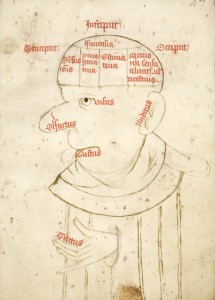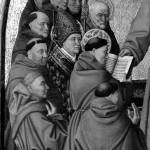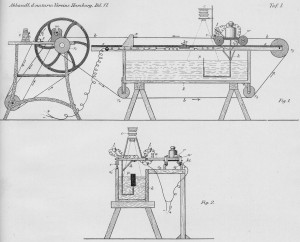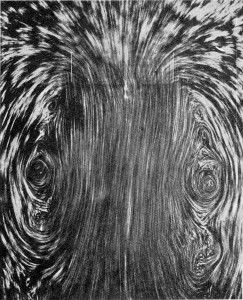by Christopher Wood
The essay begins:
Romance is a plot driven by interaction among willful, desiring persons within constraining envelopes of social conventions and natural laws. In romance, both the desire-shaping resistance to will and the acquiescence of the world in human ambitions are concretized in things, naturalia and artifacts alike, endowed with unexpected powers. Characters acquire, exchange, hide, and converse with rings, swords, articles of clothing, trees, birds, and the like. According to Italo Calvino, “The magic object is an outward and visible sign that reveals the connection between people or between events.” Such tokens function as protagonists in medieval legends and sagas, chivalric romances, the neochivalric epics of Ariosto or Spenser, and the modern novel. “Around the object there forms a kind of force field that is in fact the territory of the story itself.” The thing arrests and then restarts the plot. Interactions with things or animals substitute for interpersonal, psychological relations when the literary means to represent such relations are lacking. The bundle of shifting desires and emotions that is a person can more easily “settle” on a jewel or a horse than on another unstable person.
In the romance, the thing provides a background against which personhood is profiled. The thing shares some qualities with persons but lacks other crucial attributes such as will, voice, or conscience. The effects of agency granted to things within the fiction intensify awareness of the nonhuman qualities of such things outside the fiction, in reality. The gem or the ribbon comes into focus as a thing, as the reduced double of a person, inside a narrative. The thing is a precipitate of story that arrives to assist the story. The thing decenters personhood and is at the same time anthropomorphic, in the sense that it stands in for something that is prior to or outside the human, but is customized by the story for human apprehension. The anthropomorphism of animal or artifact in romance is uncanny because partial.
In the last several decades the device of partial anthropomorphism, or attribution of some human qualities to nonhuman entities, has been favored within critical and historical writing across several disciplines. The project signaled by the phrase “Images at Work,” title of the conference from which the present special issue arises, is a good example. Someone who writes or speaks about what images “want,” the “life” of things, or “things that talk” would seem to be making a claim, against common sense, about reality. I am personally unconvinced that pictures desire anything, or that images think, or that things live. Awaiting better demonstrations of such unlikelihoods, I can only speculate about what people really mean when they speak this way.
In the literary mode of romance, partial anthropomorphization signals not only an awareness of the limits of narrative to convey the whole of personhood but also an awareness of the limits of a person’s ability to control his or her own destiny. Similarly, the modern critical trope of anthropomorphization signals a recognition of, perhaps even a resignation to, the limits of personhood. To speak about nonsentient things as if they were almost persons is to ironize the concept of the person. It is a way of speaking that calls attention to the way persons win unearned prestige by inserting themselves in advantageous positions within sentences. Sentences create subjects by associating substantives with predicates, including verbs. The subject is the source of the movement produced by the predicates. Grammar invites anthropomorphism, for inside a sentence or a plot you can simply replace “she” with “it,” and the verb does the rest. Sentences and plots threaten to expose the human subject as an artifact of grammar. The trope of misanthropic anthropomorphism is basically contending that people are things that have been activated by grammar. The trope is antifictional, discrediting modern stories—not just romances, but any story that exaggerates the autonomy of the person. The trope is antihumanist, if humanism is defined as the attribution of too much humanity to people. Writing reveals that from a standpoint outside writing, things would look more like persons and persons would look more like things. To redescribe reality as a series of interactions among persons and things is to replace the hierarchy of animate and inanimate entities with a nonhierarchical network.
The discourses of the “life of things,” actor-network theory, and object-oriented ontology restore credence to pre- or nonmodern anthropomorphisms and animistic psychological habits. The tactical, calculated anthropomorphisms of modern scholarly discourse overturn the modern common sense that rejects animism as superstition, undoing invidious hierarchies of enlightened and unenlightened, Western and non-Western, modern and unmodern. Enlightened thought dismissed belief in an animated cosmos as a fiction permitting people to imagine that they participate in an external world greater than they are. Enlightenment was an assault on anthropomorphism, dedicated to replacing comfortable human-shaped fictions such as “God” with the impersonal laws of physics. The modern critical discourse of animism exposes hidden anthropocentrisms within enlightened thought that support an “imperialism” of people over animals, the earth, or things. The deepest aim of the new, counter-Enlightenment animism may not be so remote from those of traditional animisms, namely, to persuade each other that we participate in something greater than ourselves: if not a cosmos, then an ecology or a system.
The visual arts are well suited to this project, even better suited than the literary arts, because images, anyway, have limited means of reproducing the words or gestures that carry interpersonal relations. A simple, effective way of reducing the person is to deprive him or her of speech. The image or picture delivers a partial person, outside grammar. Within a picture, the leveling of people and things is already half-accomplished. “In iconic communication,” according to Gregory Bateson, “there is no tense, no simple negative, no modal marker.” Modality, or open-endedness, is a key to any ambitious model of the person as emergent, contingent, and unlimited. Because art has difficulty reproducing emergence, intersubjectivity reappears within art as misrecognition and misunderstanding, as if people all along, each time they try to communicate, have been mistaking things for people. The pictorial arts, where persons and things share a mutism, give the cue to the recent critical discourses—materialist, antihumanist, and antihierarchical—that redistribute agency across a spectrum of entities. It is especially in art history, art criticism, and art theory that the anthropomorphizing discourses of the thing have taken hold. Continue reading …
This paper argues that the “anthropomorphizing” discourses that attribute agency to images and things, stressing their efficacy and power, are motivated by a perception of a lack in the artwork, or in art itself.
CHRISTOPHER S. WOOD is Professor in the Department of German at New York University. He is the author of Albrecht Altdorfer and the Origins of Landscape (1993, reissued with new afterword, 2014).
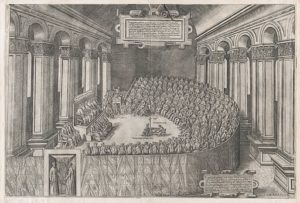 What happened when the most important genre of Renaissance painting, the historia (a “visual history”), built its images on scenes of eyewitnessed current events disseminated in the new medium of print? Is it a coincidence that a new claim to the eyewitnessing of current events in paint occurred in the fifteenth century, around the time that print made such palpably new histories available to a wide audience? While this essay will not undertake to prove that mechanical reproducibility put pressure on the historia to disseminate events as they appeared and as they happened, it will attempt to show the transformative encounter of these two things. A series of representations of a signal historical event enables us to see the convergence of the eyewitnessed image and print in action, and I propose to treat the meeting of the Council of Trent (1545–63) as my example, in part out of perversity. This event, which was in reality a visually uninteresting series of meetings (rows of people talking) spanning decades, was represented in a way that was both more textured and detailed than previous such scenes. And the long arc of time over which the council met was dealt with visually by representing what appears to be a single moment, a radical (and arbitrary) condensation in pictures—in a manner equivalent to the boiling down of a long war, with its many skirmishes, by representing a single moment in a single battle that in itself may have been of no particular significance. We will see, though, that a visual history that looks right to the eye in a given instant is still an image that has been put to work by specific agents. It was usually not sufficient merely to show a historical event; the artist had to make sense of it, to interpret it, to declare a position. The historia remained intact, and yet the eyewitnessed image, by virtue of its visual media, also had a stimulating effect as evidence-based history. Continue reading …
What happened when the most important genre of Renaissance painting, the historia (a “visual history”), built its images on scenes of eyewitnessed current events disseminated in the new medium of print? Is it a coincidence that a new claim to the eyewitnessing of current events in paint occurred in the fifteenth century, around the time that print made such palpably new histories available to a wide audience? While this essay will not undertake to prove that mechanical reproducibility put pressure on the historia to disseminate events as they appeared and as they happened, it will attempt to show the transformative encounter of these two things. A series of representations of a signal historical event enables us to see the convergence of the eyewitnessed image and print in action, and I propose to treat the meeting of the Council of Trent (1545–63) as my example, in part out of perversity. This event, which was in reality a visually uninteresting series of meetings (rows of people talking) spanning decades, was represented in a way that was both more textured and detailed than previous such scenes. And the long arc of time over which the council met was dealt with visually by representing what appears to be a single moment, a radical (and arbitrary) condensation in pictures—in a manner equivalent to the boiling down of a long war, with its many skirmishes, by representing a single moment in a single battle that in itself may have been of no particular significance. We will see, though, that a visual history that looks right to the eye in a given instant is still an image that has been put to work by specific agents. It was usually not sufficient merely to show a historical event; the artist had to make sense of it, to interpret it, to declare a position. The historia remained intact, and yet the eyewitnessed image, by virtue of its visual media, also had a stimulating effect as evidence-based history. Continue reading … EVONNE LEVY is Professor of Early Modern Art History at the University of Toronto. She works on the art, architecture, and historiography of the baroque in Europe and Latin America.
EVONNE LEVY is Professor of Early Modern Art History at the University of Toronto. She works on the art, architecture, and historiography of the baroque in Europe and Latin America.
